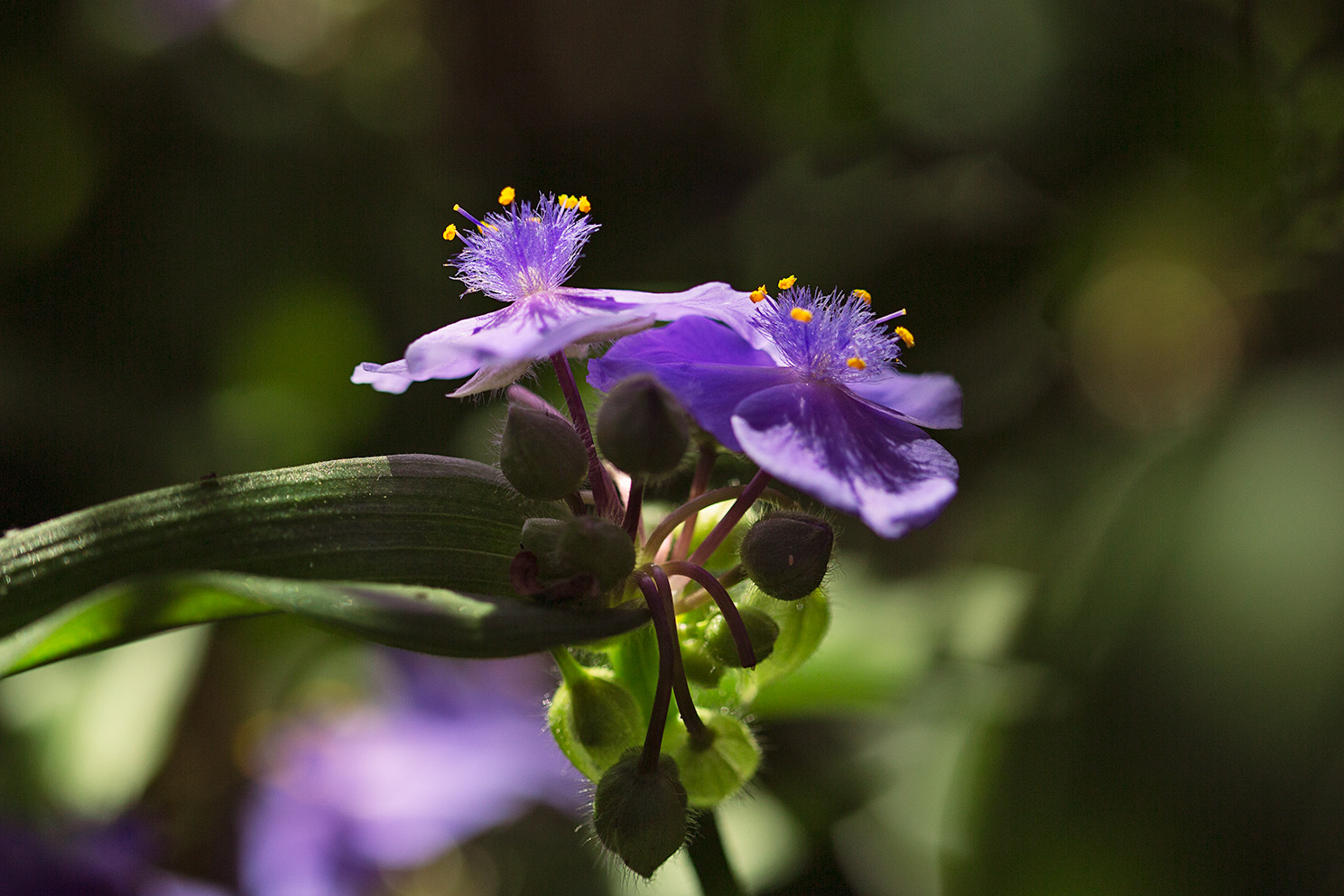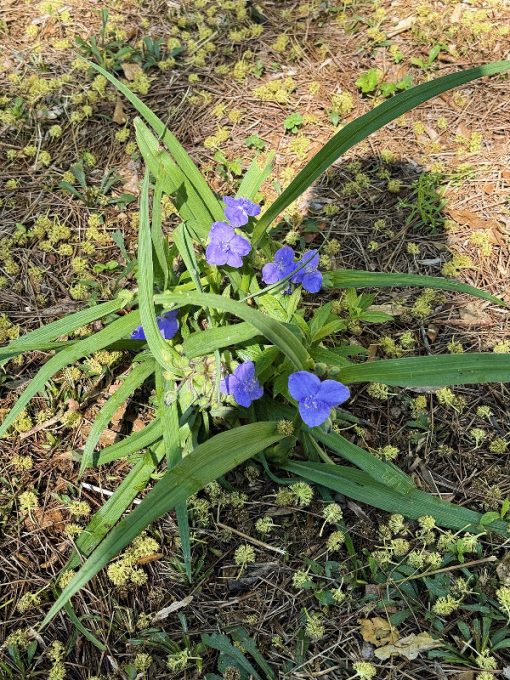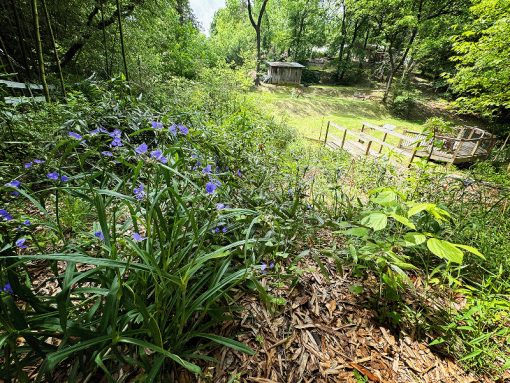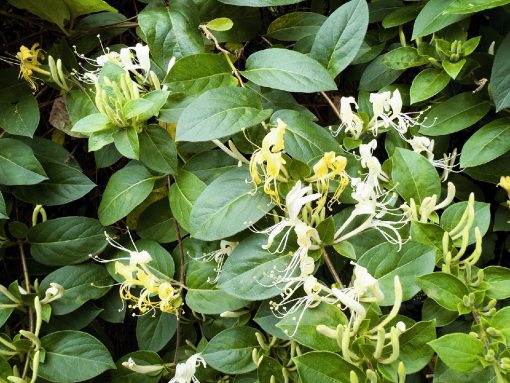First published in the June 2024 edition of Grapevine, the newsletter for Yamhill County Master Gardeners.
A Wildflower to Fight Wildfires – Virginia Spiderwort
A lifelong Oregonian transplanted in Roswell, Georgia, travels both backward and forward in time. Pre-Civil War homes seem frozen in a bygone era as the gardens skip ahead to summer. The April landscape is lush and rose-filled. The growing season is not foiled by lingering frosts or soggy soil.
The southeastern climate silences familiar signs of spring. There is no perennial pop of technicolor tulips. This land is instead tuned to the sultry deep southern blues of Tradescantia virginiana (trad-es-KAN-tee-uh vir-jin-ee-AN-uh).
Virginia spiderwort (or spider lily) sparks curiosity. Delicate terminal flowers are an intense indigo in the shade and violet in the sun. The stamens sport long-blue hairs with a showy, neon-yellow tip. The lead flower greets the morning atop spider-legged leaves. It later disintegrates to a blob of jelly – a wildflower “widow’s tear.” A cluster of buds await below in a succession plan that keeps the plant blooming for months.
Researching the plant fanned a flicker of interest into a purple-blue blaze. Spiderwort is a native plant with 85 species across the Americas. The perennial checks many boxes on a gardener’s coveted plant list. The dayflower is bee friendly, edible, and medicinal. It is also disease-free, long-blooming, deer resistant, and fire resistant.
Climate change and wildfires are at the forefront of many worried minds. It turns out that home gardeners are far from helpless. Proper plant selection and placement can reduce wildfire risk in rural and urban settings.
In Oregon landscapes the prairie/western spiderwort, Tradescantia occidentalis, is a native plant helpful in creating “defensible space.” Firefighters can use a plant delay in a blaze’s path to better contain a fire and protect a home. The National Fire Protection Association’s Home Ignition Zone was created for homeowners to encourage firewise practices when landscaping. The guidelines address strategies for 0-5, 5-30, and 30-100 feet from a residence.
Designing a firewise landscape requires that no vegetation be within five feet of the home. Perennials and shrubs come into play in the area 5-30 feet from a structure. The botanicals that make the fire-resistant list produce fewer embers and do not contribute to fire intensity. Branching patterns are open and loose. Sap is water like and odor free. Leaves are moist and supple.
Fire-resistant plants are not “fireproof.” They will not stop a fire. But they do give firefighters more time and a better chance at gaining control of the situation. The plants, groundcover materials, and watering solutions we choose make a significant difference in overall wildfire risk. For example, a return to overhead watering could encourage fire-resistant mycorrhizal networks with an evenly damp environment.
To develop a complete firewise landscape plan, search for “fire resistant” on extension.oregonstate.edu and grassrootsecology.org.
Spiderwort is a popular choice for Georgia gardeners. It is far less prolific in Pacific Northwest landscapes. This is surprising for a backyard habitat stunner and native plant that Xerces Society recognizes as one of “Special Value to Native Bees.” Spiderwort would pair well with a wide-array of attractive, fire-resistant favorites. That list includes chives, columbine, bleeding heart, coneflower, coral bells, and lavender.
Tradescantia occidentalis is excellent naturalized in a wildflower or prairie garden. It also looks at home in rock gardens and small borders. While sources suggest the plant tolerates full sun, personal observation disagrees. The plants wither and drop flowers fast in heat. Blooms with afternoon shade appear much happier.
Tradescantia virginiana has a rich history in Cherokee culture. The mashed root treated wounds, and the powdered flowers stopped nosebleeds. Young leaves were mixed into salads. The aloe-like mucus from the leaves relieved – you guessed it – spider bites. The plant earned the name “Indian paint” from the Lakota who made blue paint from the flowers to decorate clothing.
In addition to being firewise, Spiderwort flowers are sensitive to radiation. The stamen turns from blue to bright pink upon exposure. The plants have become the “canary in a coal mine” for nuclear plants in Japan. Spiderwort is planted in the surrounding area. Damaged pink flowers provide early warning of dangerous levels of radiation.
Carl Linnaeus named Tradescantia virginiana after John Tradescant (1608-1662) a royal gardener, plant hunter, and forefather of the modern English garden. Tradescant and his namesake son introduced many hundreds of species of plants, shrubs and trees that have become part of the modern garden’s repertoire. Many of the flowers Tradescant collected, like the common spiderwort, were fragrance free. He had no sense of smell, so scent was not considered. He likely didn’t consider fire-resistance either.
One of the most flammable materials used for ground covers is pine straw. It is ironic to see Georgia gardens with fire-resistant spiderwort tucked into fluffy beds of parched pine straw. Perhaps the rampant honeysuckle vines will tip the scales in Georgia’s favor. Honeysuckle is rich with saponin – a fire-resistant soap – and is often the only “vine” approved in a firewise landscape. The invasive Japanese species in the southeast may be creating a living, fragrant firewall.
For this Oregon gardener, spiderwort will be a welcome addition to a firewise, native perennial border. The plant satisfies many personal requirements including an enchantment with blue flowers. It disappoints only in that the fragile, lily-like flowers resist preservation. Attempts to pick and press the blooms were a complete failure. The Widow’s tears disintegrate and stick to paper. Tradescantia virginiana is best enjoyed outdoors and shared with the bees.
If you’ve enjoyed this post then please consider subscribing to my mailing list. You’ll get a quick note whenever something new is on my blog. Sign up here.
Article Resources and More Information:
- Oregon State University: https://extension.oregonstate.edu/catalog/pub/pnw-590-fire-resistant-plants-home-landscapes
- Native American Ethnobotonay DB: http://naeb.brit.org/uses/40517/
- Grassroots Ecology: https://www.grassrootsecology.org/fire-resistant-habitat-at-home




